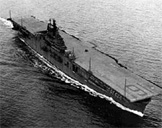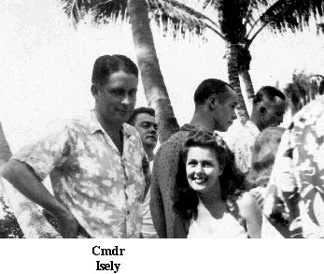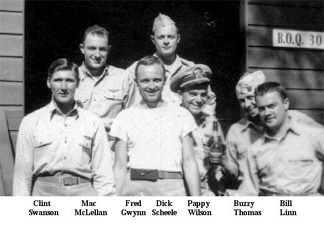|
Fred Gwynn's Chapter 3 |
|||||||||||
 |
|||||||||||
 |
|||||||||||
|
There was some doubt as to whether the Lex could scrape through the Canal locks, even when the catwalks had been trussed up and the radio masts up-righted. Everyone knew that the beam of American ships is limited by the width of the Canal, but it was tempting to imagine that some sand-hog welder had forgotten to measure some inconspicuous gallery that would now rip off, noisily and shamefully. And it happened, too.
But the Lexington got through the day-long trip, and in the afternoon I got my first look at the Pacific Ocean. For all my labored avoidance of cliché, I must admit to three obvious but extremely sincere thoughts that leapt to mind at this well defined moment. I thought of Keats and Keats's Cortez. I thought of how this Pacific Ocean was to be our home for the next year. And I thought, inevitably and anxiously, They Call It Pacific. The first day in this new sea I saw a five foot hammer-head shark twisting away from our cleaving bow, in ugly contrast to the playful flying-fish and porpoises that seemed to be the only inhabitants of the Atlantic surfaces. Yet we continued our training program as arduously in the western sea as in the eastern, and tamping and snafus never ceased. The familiar term "snafu," when applied to carrier aviation, signifies a practice group attack, where fighters, dive-bombers, and torpedo-bombers fly out a hundred miles or so and then come in to attack the carrier, sometimes strafing and bombing a sled towed by the ship, and dropping water-filled bombs to simulate torpedo drops. This also gives the ship's radar a real work-out and her gunners a tiresome exercise in standing by. These practice attacks are snafu simply because of the practical difficulty in getting forty or fifty planes off the deck, joined up, and co-ordinated in their attack. A term we picked up later - "Group Grope" - is more vivid and original. There was a good deal of excitement, therefore, when it was bruited about that on the morning of August 9th, the Air Group would make its final simulated attack on - of all places - Pearl Harbor. While this assured us that we really were going to Pearl and not to San Diego or the Aleutians, it also inspired the memory of another more famous attack. Would the anti-aircraft crews and interceptor pilots assigned to defend Pearl Harbor (we wondered) be forewarned of the mock attack? Most certainly, was the answer, but we were convinced that somebody would screw up the works, and that all Hawaii would be up in arms at our arrival. However, the whole project was vastly exciting, and I was heart-broken that Bill Linn and I, as boot ensigns and Numbers 19 and 20 in an 18-plane squadron, were not on the flight schedule. But when the ship tied up at Pearl that afternoon, I thanked God that we had missed the hop. Meat-Axe Thompson, a solid character and a knowledgeable pilot, had made his bombing run simultaneously with the man ahead of him, Benny Williams, had collided with Ben's plane, turned over and plunged into a street in the Navy Yard's dock area, killing himself, his gunner Lessard, his radioman, Tussing, and a number of civilian workers just arriving on the morning bus. It was a tragic way for all these lives to end, so near to combat and yet just removed from it. And it was a tragic entrance into the combat zone for Torpedo 16. We buried Meat-Axe and his boys in the cemetery hastily built for the dead of the December 7th attack. |
|||||||||||
| Military deaths must be put from the mind quickly, and it was done, for we now began a new and more rigorous program of flight training, with emphasis on night work with the aid of radar. We acquired a radar officer, Ensign Paul Dana, who thereupon assumed a unique role in carrier aviation. With a Groton-Harvard background and with eyes pronounced unfit for military service, Dana had wangled his way into radar classification and then into a very active job. |
|||||||||||
 |
|||||||||||
| As far as I have heard, he was one of the two officers in the Navy who flew into combat as a regular occupant of a carrier-based plane. An interesting rapport sprung up between this ambitious non-pilot and his pilot, Lt.-Cdr. Isely. They were practically the only people who could handle each other without friction, to exaggerate for the sake of stating a half-truth.
Torpedo 16 had picked up another pilot, Wally Larson, in Norfolk, and the unit was now getting along nicely. We were stationed on Ford Island, the naval airbase at Pearl Harbor, and a far from unpleasant center of activity. While the old Oklahoma, Utah, and Arizona still lay mostly below the water-line, and the charred hangar at Hickam Field still twisted uselessly, there was little to remind one of the Japanese holocaust of twenty months before. |
|||||||||||
| The B.O.Q. was cool and it was landscaped with fragrant blooms. The food was fabulously good: real milk, as much lettuce and scallions you wanted, eggs and waffles cooked to your order at breakfast, and plenty of variety. There was the Tennis Club up on the hill, where captains and ensigns played tennis, swam in the bright clean pool, and drank Planter's Punches at the attractive if crowded bar. |
|||||||||||
 |
|||||||||||
| Down at the new B.O.Q. was another club, and although both bars closed at seven, you could get as drunk as you liked, eat a tremendous and good dinner, and go right to bed on the cool lanai overlooking the many ships at anchor. We had liberty every fourth day, and though Honolulu didn't seem much to us at the time and Waikiki was quarantined for dengue fever, we had a good time buying leis and grass skirts and flowered swimming-trunks and sending home gifts. Hawaii wasn't quite the armed camp we had expected. End of Page 2 of Chapter 3 — Go to Page 3 Page — 1 — 2 — 3 — this chapter you may go to Introduction — Table of Contents Chapter — 1 — 2 — 3 — 4 — Epilogue — or Go to the Lexington Stories Cover Page Or Home - Contact Us - Cold War Hist. - 91st SRS Hist. - Stardust 40 Mission Story |
|||||||||||